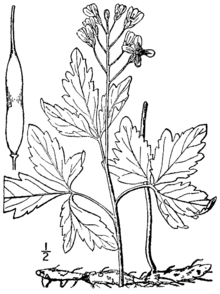Cardamine maxima
| Cardamine maxima | |
|---|---|

| |
| Scientific classification | |
| Kingdom: | Plantae |
| Clade: | Tracheophytes |
| Clade: | Angiosperms |
| Clade: | Eudicots |
| Clade: | Rosids |
| Order: | Brassicales |
| Family: | Brassicaceae |
| Genus: | Cardamine |
| Species: | C. maxima
|
| Binomial name | |
| Cardamine maxima | |
| Synonyms[3] | |
|
Homotypic Synonyms
Heterotypic Synonyms
| |
Cardamine maxima is a species of flowering plant in the mustard family Brassicaceae.[3]
Taxonomy[edit]
Cardamine maxima was first described as Dentaria maxima by the English botanist Thomas Nuttall in 1818.[4][5] The American botanist Alphonso Wood placed Dentaria maxima Nutt. in genus Cardamine in 1870.[2][6] The name Cardamine maxima (Nutt.) Alph.Wood is widely used today.[1][3][7][8][9][10]
Cardamine maxima is a member of the Cardamine concatenata alliance, a monophyletic group of eastern North American species that includes Cardamine angustata, Cardamine concatenata, Cardamine diphylla, Cardamine dissecta, Cardamine incisa, and Cardamine maxima.[11] All members of the alliance were previously placed in genus Dentaria Tourn. ex L., which is now considered to be a synonym for Cardamine L.[12]
Distribution and habitat[edit]
Cardamine maxima is native to eastern North America. Its range extends north to New Brunswick and Québec, south to Pennsylvania and New Jersey, and west to Ontario and Wisconsin.[11] It is known to occur in the following provinces and states:[3][13]
- Canada: New Brunswick, Ontario, Québec
- United States: Connecticut, Maine, Massachusetts, Michigan, New Jersey, New York, Ohio, Pennsylvania, Vermont, Wisconsin
In the United States, its distribution is centered in New York and western New England (Connecticut, Massachusetts, Vermont).[14]
Conservation[edit]
The global conservation status of Cardamine maxima is secure (G5).[1] However, outside of New York (its center of distribution) it is uncommon (S3) at best.
References[edit]
- ^ a b c "Cardamine maxima". NatureServe Explorer. NatureServe. Retrieved 10 June 2023.
- ^ a b "Cardamine maxima (Nutt.) Alph.Wood". International Plant Names Index (IPNI). Royal Botanic Gardens, Kew; Harvard University Herbaria & Libraries; Australian National Botanic Gardens. Retrieved 7 June 2023.
- ^ a b c d "Cardamine maxima (Nutt.) Alph.Wood". Plants of the World Online. Royal Botanic Gardens, Kew. Retrieved 7 June 2023.
- ^ "Dentaria maxima Nutt.". International Plant Names Index (IPNI). Royal Botanic Gardens, Kew; Harvard University Herbaria & Libraries; Australian National Botanic Gardens. Retrieved 7 June 2023.
- ^ Nuttall, Thomas (1818). The genera of North American plants, and a catalogue of the species, to the year 1817: Volume II. Philadelphia. p. 66. Retrieved 12 June 2023.
- ^ Wood (1889), Part IV, pp. 37–38.
- ^ Al-Shehbaz, Ihsan A.; Marhold, Karol; Lihová, Judita (2010). "Cardamine maxima". In Flora of North America Editorial Committee (ed.). Flora of North America North of Mexico (FNA). Vol. 7. New York and Oxford: Oxford University Press. Retrieved 7 June 2023 – via eFloras.org, Missouri Botanical Garden, St. Louis, MO & Harvard University Herbaria, Cambridge, MA.
- ^ Weakley & Southeastern Flora Team (2022).
- ^ Haines (2011).
- ^ Gilman (2015).
- ^ a b Sweeney, Patrick W.; Price, Robert A. (2001). "A multivariate morphological analysis of the Cardamine concatenata alliance (Brassicaceae)". Brittonia. 53 (1): 82–95. Retrieved 8 June 2023.
- ^ "Dentaria Tourn. ex L.". Plants of the World Online. Royal Botanic Gardens, Kew. Retrieved 8 June 2023.
- ^ "Cardamine maxima". State-level distribution map from the North American Plant Atlas (NAPA). Biota of North America Program (BONAP). 2014. Retrieved 10 June 2023.
- ^ "Cardamine maxima". County-level distribution map from the North American Plant Atlas (NAPA). Biota of North America Program (BONAP). 2014. Retrieved 10 June 2023.
Bibliography[edit]
- Gilman, Arthur V. (2015). New Flora of Vermont. Memoirs of The New York Botanical Garden, Volume 110. Bronx, New York, USA: The New York Botanical Garden Press. ISBN 978-0-89327-516-7.
- Haines, Arthur (2011). New England Wild Flower Society's Flora Novae Angliae: A Manual for the Identification of Native and Naturalized Higher Vascular Plants of New England. Illustrated by Elizabeth Farnsworth and Gordon Morrison. Yale University Press. ISBN 978-0-300-17154-9.
- Weakley, Alan S.; Southeastern Flora Team (2022). "Flora of the southeastern United States". University of North Carolina Herbarium, North Carolina Botanical Garden.
- Wood, Alphonso (1889) [First edition 1870]. Willis, Oliver R. (ed.). The New American Botanist and Florist (Revised 8th ed.). New York and Chicago: A. S. Barnes & Company. Retrieved 9 June 2023.
External links[edit]
- "Cardamine maxima — large toothwort". Go Botany. Native Plant Trust. Retrieved 10 June 2023.
- "Cardamine maxima (Nuttall) Alph.Wood". Flora of the Southeastern United States (2023 Edition). Retrieved 10 June 2023.

